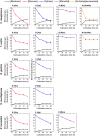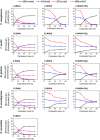Oleaginous yeasts- substrate preference and lipid productivity: a view on the performance of microbial lipid producers
- PMID: 34876116
- PMCID: PMC8650408
- DOI: 10.1186/s12934-021-01710-3
Oleaginous yeasts- substrate preference and lipid productivity: a view on the performance of microbial lipid producers
Abstract
Background: Oleaginous yeasts are promising microbial platforms for sustainable, bio-based production of biofuels and oleochemical building blocks. Bio-based residues provide sustainable and cost-effective carbon sources for fermentative yeast oil production without land-use change. Considering the regional abundancy of different waste streams, we chose complex biomass residue streams of marine origin; macroalgae hydrolysate, and terrestrial origin; wheat straw hydrolysate in the presence, and absence of corn steep liquor as a complex nitrogen source. We investigated the biomass and lipid yields of an array of well-described oleaginous yeasts; R. glutinis, T. asahii, R. mucilaginosa, R. toruloides, C. oleaginosus growing on these hydrolysates. Furthermore, their sugar utilization, fatty acid profile, and inhibitory effect of the hydrolysates on yeast growth were compared. For correlative reference, we initially performed comparative growth experiments for the strains on individual monomeric sugars separately. Each of these monomeric sugars was a dominant carbon source in the complex biomass hydrolysates evaluated in this study. In addition, we evaluated N-acetylglucosamine, the monomeric building block of chitin, as a low-cost nitrogen and carbon source in yeast fermentation.
Results: C. oleaginosus provided the highest biomass and lipid yields. In the wheat straw and brown algae hydrolysates, this yeast strain gained 7.5 g/L and 3.8 g/L lipids, respectively. Cultivation in algae hydrolysate resulted in a higher level of unsaturated fatty acids in the lipids accumulated by all yeast strains. R. toruloides and C. oleaginosus were able to effectively co-utilize mannitol, glucose, and xylose. Growth rates on wheat straw hydrolysate were enhanced in presence of corn steep liquor.
Conclusions: Among the yeast strains investigated in this study, C. oleaginosus proved to be the most versatile strain in terms of substrate utilization, productivity, and tolerance in the complex media. Various fatty acid profiles obtained on each substrate encourage the manipulation of culture conditions to achieve the desired fatty acid composition for each application. This could be accomplished by combining the element of carbon source with other formerly studied factors such as temperature and oxygen. Moreover, corn steep liquor showed promise for enhancement of growth in the oleaginous strains provided that carbon substrate is available.
Keywords: Biomass yield; Carbon substrate preference; Complex lignocellulosic/marine biomass hydrolysate; Fermentation inhibitor tolerance; Lipid yield; Oleaginous yeasts.
© 2021. The Author(s).
Conflict of interest statement
The authors declare that they have no competing interests.
Figures





Similar articles
-
Screening of xylose utilizing and high lipid producing yeast strains as a potential candidate for industrial application.BMC Microbiol. 2022 Jul 7;22(1):173. doi: 10.1186/s12866-022-02586-y. BMC Microbiol. 2022. PMID: 35799117 Free PMC article.
-
Oleaginous yeasts respond differently to carbon sources present in lignocellulose hydrolysate.Biotechnol Biofuels. 2021 May 29;14(1):124. doi: 10.1186/s13068-021-01974-2. Biotechnol Biofuels. 2021. PMID: 34051838 Free PMC article.
-
Oleaginous yeasts for biochemicals, biofuels and food from lignocellulose-hydrolysate and crude glycerol.Yeast. 2023 Aug;40(8):290-302. doi: 10.1002/yea.3838. Epub 2023 Jan 19. Yeast. 2023. PMID: 36597618 Review.
-
Oleaginous yeasts from Antarctica: Screening and preliminary approach on lipid accumulation.J Basic Microbiol. 2016 Dec;56(12):1360-1368. doi: 10.1002/jobm.201600099. Epub 2016 Jun 10. J Basic Microbiol. 2016. PMID: 27283113
-
Potential of Rhodosporidium toruloides for Fatty Acids Production Using Lignocellulose Biomass.Appl Biochem Biotechnol. 2024 May;196(5):2881-2900. doi: 10.1007/s12010-023-04681-w. Epub 2023 Aug 24. Appl Biochem Biotechnol. 2024. PMID: 37615852 Review.
Cited by
-
Screening of xylose utilizing and high lipid producing yeast strains as a potential candidate for industrial application.BMC Microbiol. 2022 Jul 7;22(1):173. doi: 10.1186/s12866-022-02586-y. BMC Microbiol. 2022. PMID: 35799117 Free PMC article.
-
Non-canonical D-xylose and L-arabinose metabolism via D-arabitol in the oleaginous yeast Rhodosporidium toruloides.Microb Cell Fact. 2023 Aug 3;22(1):145. doi: 10.1186/s12934-023-02126-x. Microb Cell Fact. 2023. PMID: 37537595 Free PMC article.
-
Mastering targeted genome engineering of GC-rich oleaginous yeast for tailored plant oil alternatives for the food and chemical sector.Microb Cell Fact. 2023 Feb 8;22(1):25. doi: 10.1186/s12934-023-02033-1. Microb Cell Fact. 2023. PMID: 36755261 Free PMC article.
-
Expanding the genetic toolbox for Cutaneotrichosporon oleaginosus employing newly identified promoters and a novel antibiotic resistance marker.BMC Biotechnol. 2023 Sep 18;23(1):40. doi: 10.1186/s12896-023-00812-7. BMC Biotechnol. 2023. PMID: 37723521 Free PMC article.
-
Potential role of alginate in marine bacteria-yeast interactions.Appl Environ Microbiol. 2024 Dec 18;90(12):e0168324. doi: 10.1128/aem.01683-24. Epub 2024 Nov 8. Appl Environ Microbiol. 2024. PMID: 39513721 Free PMC article.
References
-
- Escobar JC, Lora ES, Venturini OJ, Yáñez EE, Castillo EF, Almazan O. Biofuels: environment, technology and food security. Renew Sustain Energy Rev. 2009;13(6):1275–1287.
-
- Searchinger T, Heimlich R, Houghton RA, Dong F, Elobeid A, Fabiosa J, et al. Use of U.S. croplands for biofuels increases greenhouse gases through emissions from land-use change. Science. 2008;319(5867):1238. - PubMed
-
- Pfleger BF, Gossing M, Nielsen J. Metabolic engineering strategies for microbial synthesis of oleochemicals. Metab Eng. 2015;29:1–11. - PubMed
-
- Vasconcelos B, Teixeira JC, Dragone G, Teixeira JA. Oleaginous yeasts for sustainable lipid production—from biodiesel to surf boards, a wide range of “green” applications. Appl Microbiol Biotechnol. 2019;103(9):3651–3667. - PubMed
-
- Fargione J, Hill J, Tilman D, Polasky S, Hawthorne P. Land clearing and the biofuel carbon debt. Science. 2008;319(5867):1235. - PubMed
MeSH terms
Substances
Supplementary concepts
Grants and funding
LinkOut - more resources
Full Text Sources
Other Literature Sources

